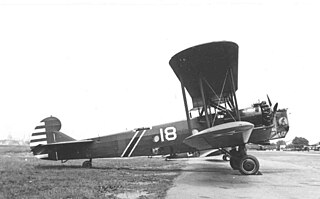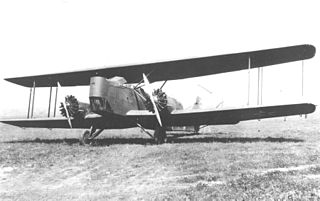
The Boeing XB-15 was a United States bomber aircraft designed in 1934 as a test for the United States Army Air Corps (USAAC) to see if it would be possible to build a heavy bomber with a 5,000 mi (8,000 km) range. For a year beginning in mid-1935 it was designated the XBLR-1. When it first flew in 1937, it was the most massive and voluminous airplane ever built in the US. It set a number of load-to-altitude records for land-based aircraft, including carrying a 31,205 lb (14,154 kg) payload to 8,200 ft (2,500 m) on 30 July 1939.

The Curtiss B-2 Condor was a 1920s United States bomber aircraft. It was a descendant of the Martin NBS-1, which was built by the Curtiss Aeroplane and Motor Company for the Glenn L. Martin Company. There were a few differences, such as stronger materials and different engines, but they were relatively minor.

The Keystone B-6 was a biplane bomber developed by the Keystone Aircraft company for the United States Army Air Corps.

The Douglas Y1B-7 was a 1930s American bomber aircraft. It was the first US monoplane given the B- 'bomber' designation. The monoplane was more practical and less expensive than the biplane, and the United States Army Air Corps chose to experiment with monoplanes for this reason. At the time the XB-7 was ordered, it was being tested by Douglas Aircraft as an observational plane.

The Fokker XB-8 was a bomber built for the United States Army Air Corps in the 1930s, derived from the high-speed Fokker O-27 observation aircraft.
The Martin XB-16, company designation Model 145, was a projected heavy bomber designed in the United States during the 1930s.

The North American XB-28 (NA-63) was an aircraft proposed by North American Aviation to fill a strong need in the United States Army Air Corps for a high-altitude medium bomber. It never entered production, with only two prototypes being built.

The Lockheed XB-30 was the design submitted by Lockheed after the request by the United States Army Air Forces for a very heavy bomber, the same request that led to the Boeing B-29 Superfortress, the Douglas XB-31 and Consolidated B-32 Dominator.

The Boeing YB-9 was the first all-metal monoplane bomber aircraft designed for the United States Army Air Corps. The YB-9 was a much enlarged twin-engine development of Boeing's single-engine Model 200 Monomail commercial transport.

The Curtiss A-18Model 76A Shrike II was a 1930s United States twin-engine ground-attack aircraft. It was the production test version of that company's A-14 Shrike.

Huff-Daland was an American aircraft manufacturer. Formed as Ogdensburg Aeroway Corp in 1920 in Ogdensburg, New York by Thomas Huff and Elliot Daland, its name was quickly changed to Huff-Daland Aero Corp and then in 1925 it was changed again to Huff-Daland Aero Company with its main headquarters in Bristol, Pennsylvania. Huff-Daland produced a series of biplanes as trainers, observation planes, and light bombers for the U.S. Army and Navy.

The Curtiss T-32 Condor II was a 1930s American biplane airliner and bomber aircraft built by the Curtiss Aeroplane and Motor Company. It was used by the United States Army Air Corps as an executive transport.

The Keystone LB-6 and LB-7 were 1920s American light bombers, built by the Keystone Aircraft company for the United States Army Air Corps, called Panther by the company, but adoption of the name was rejected by the U.S. Army.

The Huff-Daland LB-1 was an American biplane light bomber aircraft operated by the United States Army Air Service in the 1920s.

The Martin NBS-1 was a military aircraft of the United States Army Air Service and its successor, the Army Air Corps. An improved version of the Martin MB-1, a scout-bomber built during the final months of World War I, the NBS-1 was ordered under the designation MB-2 and is often referred to as such. The designation NBS-1, standing for "Night Bomber-Short Range", was adopted by the Air Service after the first five of the Martin bombers were delivered.

The Keystone LB-5 was a bomber aircraft produced in the United States in the late 1920s. Its manufacturer nicknamed it the Pirate, but this name was not officially adopted by the United States Army Air Corps (USAAC).

The Keystone XLB-3 was a prototype bomber biplane developed in the United States in the late 1920s. It was a twin-engine development of the single-engine LB-1, brought about by a change in policy by the United States Army Air Corps (USAAC).

The Huff-Daland XHB-1 "Cyclops" was a 1920s American prototype heavy bomber designed and built by the Huff-Daland company.

The Curtiss CT-1 model 24, a twin engine torpedo bomber mounted on floats, was first flown in 1921.
The Martin XLB-4 was a 1920s proposal for a light bomber by the Glenn L. Martin Company.



















